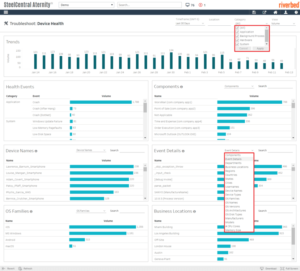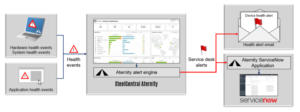Benchmarking Desktop Support Cost Per Ticket – How Aternity Helps You Improve
 SteelCentral Aternity is widely used by End User Services teams in both enterprises and IT service providers. Aternity’s approach to End User Experience Monitoring enables these teams to improve their Key Performance Indicators (KPIs) by proactively identifying and resolving end user issues and device problems. The first blog in this series covered Service Desk cost per ticket. In this blog, we’ll take a look at another KPI for the end user services team – desktop support cost per ticket.
SteelCentral Aternity is widely used by End User Services teams in both enterprises and IT service providers. Aternity’s approach to End User Experience Monitoring enables these teams to improve their Key Performance Indicators (KPIs) by proactively identifying and resolving end user issues and device problems. The first blog in this series covered Service Desk cost per ticket. In this blog, we’ll take a look at another KPI for the end user services team – desktop support cost per ticket.
Desktop support teams handle two types of tickets
HDI, the association of technical support professionals industry, has gathered a variety of useful resources in its library. A Jeff Rumberg article provides a detailed analysis of the drivers of desktop support cost per ticket. Just like service desk costs, agent salary and benefits make up the majority of desktop support operational costs. In the case of desktop support, these contribute 62% of the total, vs only 51% for the service desk.
 Desktop support teams handle two types of tickets. Service requests are work items that are planned, such as hardware refreshes, Windows 10 migrations, or any type of upgrade. Incidents are unplanned work items affecting device health, such as unplanned shutdowns, blue screens of death, memory failures, bad blocks, etc.
Desktop support teams handle two types of tickets. Service requests are work items that are planned, such as hardware refreshes, Windows 10 migrations, or any type of upgrade. Incidents are unplanned work items affecting device health, such as unplanned shutdowns, blue screens of death, memory failures, bad blocks, etc.
What drives desktop support cost per ticket?
So the total number of tickets handled by the desktop support team is the sum of the incidents and the service requests. Therefore, desktop support cost per ticket is the weighted average of cost per incident and cost per service request. Service requests generally require more work time than incidents. This results in higher costs, as shown by the data below from MetricNet’s 2016 survey.

The range of Desktop Support cost per ticket is driven by the huge variation in cost per service request
Source: Metric of the Month: Desktop Support Cost per Ticket, Jeff Rumberg, HDI, October 2017
Just as with service desk cost per ticket, ticket handle time and engineer utilization are the key operational factors that affect ticket costs. The more work the engineer has to do on the ticket, the higher the cost. Lower ticket numbers worked drive lower utilization and higher costs.
The concentration of workforce end users to be supported affects both of these factors. For example, an engineer working for a retail banking company will support users located in widely distributed branch offices. This environment requires significant travel time, which increases handle time and costs. An engineer who supports a workforce in a city office building can easily support a large number of users, resulting in a lower Desktop Support cost per ticket.
As the article explains, IT executives need to account for desktop support cost per ticket AND customer satisfaction. Higher cost per ticket is not necessarily bad, if it results in higher customer satisfaction.
How Aternity helps reduce desktop support cost per ticket
Desktop support teams use Aternity End User Experience Monitoring to proactively identify and resolve end user and device incidents. As the dashboard below shows, Aternity tracks a range of device health events affecting applications, the system, and the hardware of end user devices. With Aternity, desktop support teams can identify all impacted users, before they call to complain. They can analyze incidents by office location, operating system, or a variety of other metrics.
With Aternity, desktop support teams can review all open incidents and assign them to engineers based on geographic coverage or by technical expertise. This can help reduce work time per ticket and raise engineer utilization.

Aternity tracks a range of device health events affecting applications, the system, and the hardware of end user devices
Aternity triggers a service desk alert when the same application, hardware, or system problem occurs within a specified period of time. For example, it can trigger a service desk alert when a retailer’s point-of-sale application crashes more than twice a day on any device in any location. You can configure these alerts to be sent via email to your desktop support team to proactively notify them of issues BEFORE users complain. This reduces ticket handle time and raises end user satisfaction.

Aternity service desk alerts can be sent to the Desktop Support team by email or to your ServiceNow instance
Aternity is now integrated with ServiceNow
The latest release of Aternity further reduces desktop support cost per ticket. It provides a bi-directional integration with ServiceNow, for a closed-loop system of proactive notification and incident investigation. The integration enables your Desktop Support team to receive Aternity alerts in ServiceNow. In ServiceNow, they can drill down from an individual incident directly to the relevant Aternity dashboard for further trouble shooting. Read about the Aternity and ServiceNow integration here. Or watch this short video to see the Aternity-ServiceNow integration in action:
Next steps
 Your Desktop Support team may be part of your enterprise IT staff. Or it perhaps you use an MSP like BlueAlly or IT outsourcer, like DXC, Unisys, or Dimension Data. No matter the case, Aternity can help you reduce Desktop Support cost per ticket. To explore all of Aternity’s use cases, register for instant access to Aternity running in our cloud environment.
Your Desktop Support team may be part of your enterprise IT staff. Or it perhaps you use an MSP like BlueAlly or IT outsourcer, like DXC, Unisys, or Dimension Data. No matter the case, Aternity can help you reduce Desktop Support cost per ticket. To explore all of Aternity’s use cases, register for instant access to Aternity running in our cloud environment.
If you are an Aternity customer, download the Aternity app on the ServiceNow Store. To begin receiving Aternity alerts, contact the Aternity SaaS Admin to configure your Aternity system with the URL of your ServiceNow instance. Then you’ll be on your way to reducing desktop support cost per ticket!
